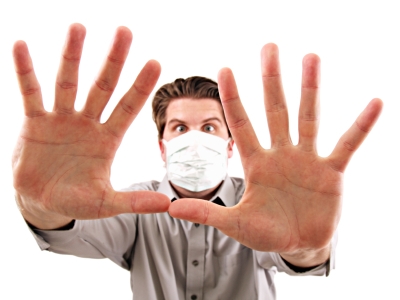 5. The swimming pool
5. The swimming pool
Can you imagine death by Swimmer’s Ear? That is exactly what could happen if you contract the bacterium Pseudomonas aeruginosa or P. aeruginosa.
P. aeruginosa can infect numerous parts of the body including the heart and blood, central nervous system, eyes, ears, the urinary tract, lungs, skin and soft tissue.
A common mode of transmission is contaminated water in swimming pools, sinks and tubs.
If you didn’t think the yellow-green foul smelling pus draining from your ear was troubling enough, a bad case of swimmer’s ear can spread from the ear canal to the nearby tissues and into the bones of the base of the skull. If the infection isn’t stopped, it can infect the cranial nerves, brain and other parts of the body.
The best course of action to combat this microbe is asking the owner of the pool or hot tub how often disinfectant and pH levels are checked (the CDC suggests twice per day).
6. The Midsummer nightmare
It’s hard to believe that one little irritating summertime pest can destroy your health in such a big way.
The Malaria parasites or Plasmodium are typically contracted to humans via the female Anopheles mosquito. While there are four categories of this parasite, the most lethal is Plasmodium falciparum. Malaria is a disease of the blood that can be easily detected by a blood test.
While Malaria is a serious concern in Africa, lately the disease has made its way to the U.S. In 2009, the CDC received 1,484 cases of malaria among people in the U.S. and its territories, a 14 percent increase from 2008. Most Americans infected with Malaria were returning home from visiting tropical and subtropical countries.
Symptoms include chills, fever, sweating, jaundice and anemia.
Malaria can be treated with prescription drugs but treatment depends on the severity of the disease, the species of the malaria parasite and where the infection was acquired. If you are infected by Plasmodium falciparum it can cause kidney and liver failure, coma and death.
Researchers have learned recently that this cunning parasite has managed to build resistance against common anti-malaria drugs. There currently isn’t a vaccine to combat this strain of the disease.
 7. The family pet
7. The family pet
Small but mighty, ticks are not only a concern when it comes to your pets. Borrelia burgdorferi or B. burgdorferi is a dangerous bacterium carried by deer ticks.
These miniscule bloodsuckers feast on deer and mice infected with Lyme disease who in turn bite humans and pass along the disease to them. This spirochete gets its name from the town of Lyme, Conn. where the bacterium was first discovered.
You can also be exposed to this debilitating disease through your beloved pet. If “Spot” was outside playing in the backyard and picks up ticks before coming back into the home, this doubles the chances of being bitten and contracting the disease. Walking in tall grass, playing in the yard or walking through wooded areas also increases your chances of being bitten by ticks.
If you live in Connecticut, Delaware, Maine, Maryland, Massachusetts, Minnesota, New Jersey, New Hampshire, New York, Pennsylvania, Virginia or Wisconsin, you have a greater chance of being infected.
If Lyme disease is left untreated, serious complications can occur. According to the University of Maryland Medical Center, 60 percent of untreated patients develop arthritis and about 10 percent to 20 percent of patients develop neurological disorders or heart problems.
The most maddening part of protecting yourself against Lyme disease is properly and safely detaching the bug from your skin. It is suggested you grasp the insects with tweezers close to the skin and pull straight up. Health officials warn against twisting their heads off, squishing, burning or suffocating them, since this will only push the toxin further into the skin. According to the CDC, you have 36 to 48 hours to find and remove a tick that is attached to your body before Lyme disease enters the blood stream.
8. The fling
The next time you’re out on a date take a closer look at the potential romantic interest sitting across the table from you.
The CDC reports that approximately 20 million Americans are infected with human papillomavirus (HPV) and another six million people become newly infected each year. Does your dinner date still look inviting?
If asexuality is not an option, it may be comforting to know that in 90 percent of cases the body’s immune system can clear HPV naturally within two years. However, when the body does not clear the infection it may develop into genital warts and cervical cancer. Prevention includes being vaccinated against HPV, using condoms or abstaining from sexual activity altogether.
9. The dorm
A meningitis epidemic is one of the more terrifying outbreaks for humans because it spreads so easily and can quickly result in brain damage or death.
The neisseria meningitidis bacteria infects the throat and nasal passages and may overwhelm the body’s natural defenses by flooding the bloodstream and traveling to the brain.
Coughing, kissing or sneezing can spread the bacteria. People at a greater risk of transmitting this disease are those who live in close quarters.
According to The National Meningitis Association (NMA), bacterial meningitis may result in brain damage, hearing loss or a learning disability. Other complications include loss of kidney function and limb amputations. Because of the rapid progression of the disease a full recovery is never guaranteed, according to the NMA. The CDC recommends immunizations for adolescents and college freshman living in dormitories since crowded living conditions can facilitate transmission.
10. The bathroom
The next time you use the washroom… BEWARE! The bacterium Clostridium difficile (C. difficile or C. diff) lives in people’s intestines. Transmission is primarily through touching surfaces contaminated with feces, such as toilets, bathtubs and electronic rectal thermometers and then touching your mouth.
The bacterium attacks the digestive system and causes mild to severe forms of diarrhea and colitis.
So what kills it? Not alcohol-based hand sanitizers, but good old-fashioned soap and water. Hypochlorite-based disinfectants (chlorine) may be the most effective defense against the production of C. diff spores.
This spore is frequently found in hospitals, nursing homes, extended care facilities and nurseries.
The National Library of Medicine reported that antibiotics such as ampicillin, clindamycin and cephalosporin might increase the amount of bacteria in the intestine and release toxins that can eat away at the delicate tissue of the colon.













